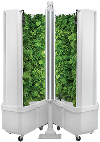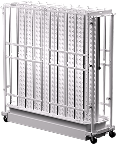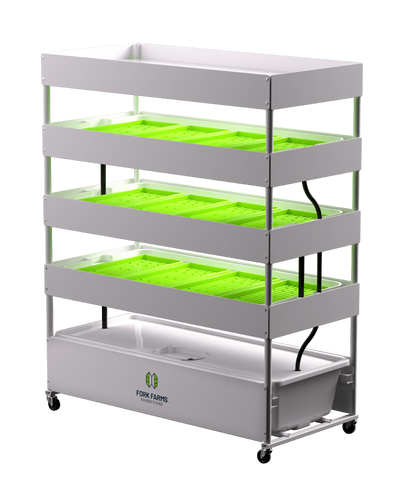Hydroponic Strawberries: Can You Grow Strawberries With An Indoor Garden?
Whether it’s their sweet and tangy flavor, nutritional value, or culinary versatility, the appeal of strawberries is undeniable. These juicy, delicious, and refreshing fruits are not only low in calories but also high in essential nutrients, making them a perfect addition to a balanced, heart-healthy diet.
Strawberries are ready-made for any occasion, as they can be enjoyed fresh without the need for peeling or extensive preparation. Their size and shape make them ideal for snacking, packing in lunches, or incorporating into various dishes.
Growing Strawberries Hydroponically
While strawberries are beloved worldwide for their taste and health benefits, they’re also one of the most popular fruits to grow hydroponically. That’s because strawberry plants are relatively easy to care for, produce fruit quickly, and thrive in a well-maintained system.
Strawberries can also grow in smaller spaces allowing you to maximize your available growing space. Plus, the high market value of these berries makes them attractive to commercial growers. Many also believe that hydroponically-grown strawberries taste better than soil-grown varieties, thanks to the superior nutrient solution that is delivered right to their roots.
Quick Primer on Hydroponic Gardening
Before getting into the specifics of growing strawberries hydroponically, let's first review our preferred technique. Simply put, hydroponics is a method of growing plants without soil, using a nutrient-rich water solution instead. This approach lets you control the delivery of nutrients, how much water is used, and the plants’ conditions and environment.
There are several types of hydroponic systems that can be used for indoor gardening. Some of the most popular options include:
- Nutrient Film Technique (NFT), which involves a shallow stream of nutrient solution that flows over the plant roots.
- Deep Water Culture (DWC), where plants are suspended in a nutrient solution with their roots submerged.
- Drip Systems, where the nutrient solution is dripped onto the plant's growing medium (coco coir, perlite, rockwool, etc.).
- Vertical Systems, which utilize vertical space by stacking layers of plants, making them ideal for small indoor areas.
The Benefits of Growing Indoors
Growing strawberries through traditional, soil-based gardening can often be successful, but also comes with some challenges. There are often seasonal limitations and space issues to consider, as well as the need for ideal growing conditions. But, good news - indoor hydroponic systems eliminate these concerns, allowing you to grow and enjoy fresh strawberries anytime and virtually anywhere. Diving a bit deeper into the main benefits of growing hydroponically.
Year-Round Production: One of the primary advantages of hydroponic gardening is the ability to grow strawberries year-round, regardless of the season or conditions outside. Indoors, everything is controlled, from lighting to temperature to humidity levels. This allows you to create and manage the perfect growing environment even in the depths of winter, or during a heatwave, or… you get the picture.
Space Efficiency: Hydroponic systems provide an excellent solution for growers who have little available space. Maybe you live in an urban setting, or your school isn’t suitable for an outdoor garden. Whatever the limitations, hydroponics addresses them through vertical setups, which can include towers or wall-mounted systems, that let you grow multiple plants within a compact area. These are ideal for small apartments, balconies, basements, classrooms, or any other space where square footage is at a premium.
Water Conservation: In addition to their limited footprint, hydroponic systems are also incredibly water-efficient. Unlike soil-based gardening, where much of the water is lost through evaporation or runoff, hydroponics uses a closed-loop system that recycles any unused water. Our Flex Farm system, for example, uses a remarkable 98% less water than traditional agriculture!
Faster Growth & Higher Yields: Plants raised in a hydroponic system often grow faster and produce higher yields than their outdoor counterparts. Because they receive the ideal blend of nutrients delivered straight to their roots, strawberry crops mature quicker and produce more frequent harvests, speeding up their average turnaround time.
Pest & Disease Control: Yet another advantage of hydroponics is the reduced threat of pests and soil-borne diseases. Because hydroponic systems are indoors and controlled, they are less susceptible to aphids, mites, and other common garden pests, which in turn limits the need for chemical pesticides. They’re also less prone to mildew, fungus, leaf spots, anthracnose, and other ailments that can disrupt or wipe out your strawberry crop.
Some of the Best Varieties of Strawberries for Hydroponics
While many different types of strawberries do well in hydroponic systems, some perform better than others. In particular, the ever-bearing and day-neutral varieties are recommended because they can produce fruit year-round. Some of the most popular choices are:
* Albion: This variety is known for its high yields, disease resistance, and tolerance for both heat and humidity, making it perfect for indoor systems. Albion strawberries are day-neutral, which means when it comes to producing fruit, it doesn’t matter how long or short the days are.
* Fern: Fern strawberries are another day-neutral variety that produce high yields in hydroponic systems. They're also compact, making them ideal for vertical setups or those with smaller footprints. Plus, Ferns are some of the more disease-resistant strawberries around.
* Quinault: Considered one of the most popular of the ever-bearing strawberries, this variety produces large, soft, and strikingly sweet fruit. Quinault strawberries are perfect for home gardens, and are also known for their impressive resistance to disease.
* Seascape: This day-neutral strawberry is one of the most prolific varieties available, producing tons of sweet, juicy, and bright red berries over the course of its growing cycle. Seascapes are easy to care for, very heat-tolerant, and resistant to most diseases.
* Yellow Wonder: For those interested in adding some color to their hydroponic garden, Yellow Wonder is an excellent choice. This variety produces yellow strawberries with a distinctive flavor that resembles…pineapple. They're also day-neutral and very compact, offering great yields per square foot.
Again, these are just a few of many options available. Don't hesitate to experiment with different varieties to see which one(s) you like best.
Tips For Growing Strawberries Indoors
Regardless of the type you choose for your garden, all strawberries have certain preferences when it comes to their environment. Generally speaking, keep the following in mind:
Lighting: Strawberries need consistent light to grow. That means at least 8-12 hours daily, although some experts recommend up to 16 hours of light. LED lights are likely your best bet, since they’re energy-efficient and offer a wide enough color spectrum to mimic natural sunlight.
Climate Control: Maintaining the right temperature and humidity levels will do wonders for your plants’ growth. Strawberries do best with daytime temperatures between 65-75°F (18-24°C), and a little cooler at night. To avoid fungal issues, the sweet spot for humidity is around 70%, give or take a few points.
Nutrients & pH Levels: To promote fruiting, strawberries should be fed a balanced nutrient solution that is high in phosphorus, along with nitrogen and potassium, as well as micronutrients like calcium, magnesium, and sulfur. A slightly acidic to neutral pH range, between 5.5 and 6.5, will help your strawberries absorb the nutrients they need to flourish.
A Berry Good Solution
The benefits of growing strawberries indoors with a hydroponic garden are clear and compelling, and well worth the effort if you’re interested in producing fresh, delicious, and pesticide-free fruits any time of year.
Remember, hydroponics should be rewarding and enjoyable, so have some fun with it! And don’t be afraid to try out different techniques or setups along the way–everyone’s experience is unique, and it may take some trial and error before you find the right formula. Success will come with practice and patience.
If you’re interested in learning more about cultivating strawberries in your very own hydroponic garden, we invite you to reach out and connect with one of our expert team members today using the form below!
Important Links:
























